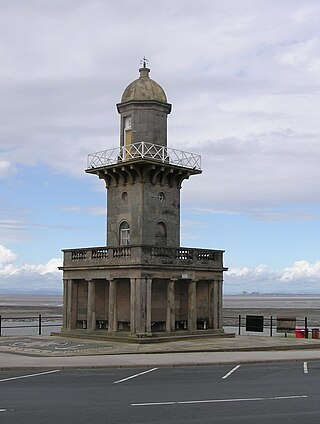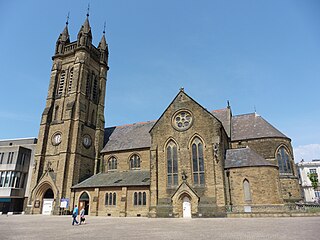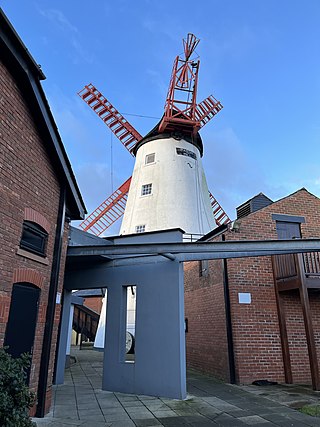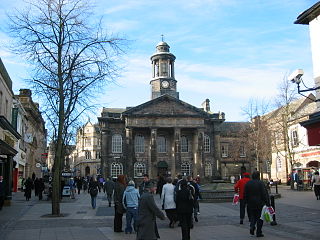
Elizabeth Cleghorn Gaskell, often referred to as Mrs Gaskell, was an English novelist, biographer, and short story writer. Her novels offer a detailed portrait of the lives of many strata of Victorian society, including the very poor. Her first novel, Mary Barton, was published in 1848. Gaskell's The Life of Charlotte Brontë, published in 1857, was the first biography of Charlotte Brontë. In this biography, she wrote only of the moral, sophisticated things in Brontë's life; the rest she omitted, deciding certain, more salacious aspects were better kept hidden. Among Gaskell's best known novels are Cranford (1851–1853), North and South (1854–1855), and Wives and Daughters (1864–1866), all of which were adapted for television by the BBC.

Lancashire hotpot is a stew originating in Lancashire in the North West of England. It consists of lamb or mutton and onion, topped with sliced potatoes and slowly baked in a pot at a low heat.

Silverdale is a village and civil parish within the City of Lancaster district of Lancashire, England. The village stands on Morecambe Bay, near the border with Cumbria, 4.5 miles (7 km) north west of Carnforth and 8.5 miles (14 km) of Lancaster. The parish had a population of 1,519 recorded in the 2011 census.

Hale is a village and civil parish in the Borough of Halton, Cheshire, England with a population of 1,800. The village is north of the River Mersey, and just to the east of the boundary with Merseyside. It is 3 miles east of Speke in Liverpool, and 4 miles south-west of Widnes. The nearby village of Halebank is to the north-east.

Warton is a village, civil parish and electoral ward in the Lancaster district of Lancashire, England. The village is close to the boundary with Cumbria, and approximately 1.5 miles (2.4 km) north of Carnforth, which was originally part of the parish of Warton. The village had a population of 2,315 at the 2001 census, and 2,360 at the 2011 census. The parish covers an area in excess of 11,000 acres (45 km2) and is predominantly rural.

84 Plymouth Grove, now known as Elizabeth Gaskell's House, is a writer's house museum in Manchester, England. The Grade II* listed neoclassical villa was the residence of William and Elizabeth Gaskell from 1850 until their deaths in 1884 and 1865 respectively. The Gaskell household continued to occupy the villa after the deaths of Elizabeth and William. The death of Elizabeth's daughter, Margaret Emily "Meta" Gaskell, in 1913, brought to an end the Gaskells' residence there.

The Beach Lighthouse is a 44-foot (13 m) tall sandstone lighthouse in Fleetwood, Lancashire, England.

Warton Crag is a limestone hill in north west Lancashire, England. It lies to the north west of Warton village, in City of Lancaster district. At 163 metres (535 ft) it is the highest point in the Arnside and Silverdale Area of Outstanding Natural Beauty, and is listed as a "HuMP" or "Hundred Metre Prominence", having a "drop" or "prominence" of 126 metres (413 ft) with its parent being Hutton Roof Crags. Two areas are Local Nature Reserves, called Warton Crag and Warton Crag Quarry. Different sections are owned by Lancashire County Council, the Wildlife Trust for Lancashire, Manchester and North Merseyside, Lancaster City Council and the Royal Society for the Protection of Birds.

The parish church of Blackpool Saint John the Evangelist, or St John's Blackpool, is an Anglican church in Blackpool, Lancashire, England. It was completed in 1878 and is a Grade II listed building. A church was built on the site in 1821 and was replaced by the current building to accommodate a larger congregation. The church was designed by Garlick, Park and Sykes in the Early English style and has been restored and renovated in 1986 and from 2000 to 2006. St John's is known as the parish church of Blackpool, and is an active parish church in the Diocese of Blackburn which is within the ecclesiastical province of York. It is in the Archdeaconry of Lancaster and the Deanery of Blackpool.

St Chad's Church is an Anglican church in Poulton-le-Fylde, Lancashire, England. It is an active parish church in the Diocese of Blackburn and the archdeaconry of Lancaster. It is recorded in the National Heritage List for England as a designated Grade II* listed building. A church on the site was built no later than the 11th century and may have existed prior to the Norman Conquest of England. The tower dates from the 17th century, and much of the remainder of the building from a major renovation in the 18th century, although some of the fabric of the original structure remains. Further renovation and additions took place in the 19th, 20th and 21st centuries.

St Peter's Church is in the seaside town of Fleetwood, Lancashire, England, situated on the Fylde coast. It is an active Anglican parish church in the Diocese of Blackburn. It was completed in 1841, to a design by Decimus Burton. Burton had been employed by Peter Hesketh-Fleetwood in 1836 to lay out the new planned town of Fleetwood. It is protected as a Grade II listed building.

St Mary's is a Roman Catholic church in Fleetwood, Lancashire, England. Designed by E. W. Pugin, it was built in 1866–67. It is an active church in the Roman Catholic Diocese of Lancaster. It has been designated a Grade II listed building by English Heritage.

The Church of St Mary and St Michael is in the village of Bonds, to the south of Garstang, Lancashire, England. It is an active Roman Catholic church in the diocese of Lancaster. The church is recorded in the National Heritage List for England as a designated Grade II listed building.

Marsh Mill is an 18th-century tower windmill in Thornton, Lancashire, England. It was built in 1794 by Ralph Slater for local landowner Bold Hesketh. It functioned as a corn mill until the 1920s and has been fully restored. It is a good example of a complete English windmill and has been designated a Grade II* listed building.

Fleetwood Museum is a local history and maritime museum in the English seaside town of Fleetwood, Lancashire. The museum was originally the town's Customs House and, completed in 1836, was one of the first buildings constructed in Fleetwood. Like much of the town it was designed by architect Decimus Burton. The building became the local town hall and is now a maritime museum. It has been designated a Grade II listed building by Historic England.

Lancaster City Museum is a museum in Lancaster, Lancashire, England. It is housed in the former Lancaster Town Hall building in Market Square.

Warton with Lindeth was a civil parish in the north of Lancashire, England, from 1866 to 1935. It had an area of 4,141 acres (1,676 ha). It was a township and became a parish in 1866. It was abolished on 1 April 1935, when 3,534 acres (1,430 ha) formed the new civil parish of Warton and 607 acres (246 ha) were added to the civil parish of Silverdale. In 1931 the parish had a population of 1694.
Silverdale is a civil parish in Lancaster, Lancashire, England. It contains 20 buildings that are recorded in the National Heritage List for England as designated listed buildings. Of these, two are at Grade II*, the middle grade, and the others are at Grade II, the lowest grade. Most of the listed buildings in the parish are houses and associated structures, or farmhouses and farm buildings. The other listed buildings include a former chimney, a church, a public house, and a limekiln.

St John's Church is in Emesgate Lane, Silverdale, Lancashire, England. It is an active Anglican parish church in the deanery of Tunstall, the archdeaconry of Lancaster, and the diocese of Blackburn. The church is recorded in the National Heritage List for England as a designated Grade II* listed building. It is notable for the high quality of the stone carving in the interior.

Jenny Brown's Point is a small headland in Silverdale parish, south of the village of Silverdale, in City of Lancaster district, Lancashire, England, on the edge of Morecambe Bay.



















